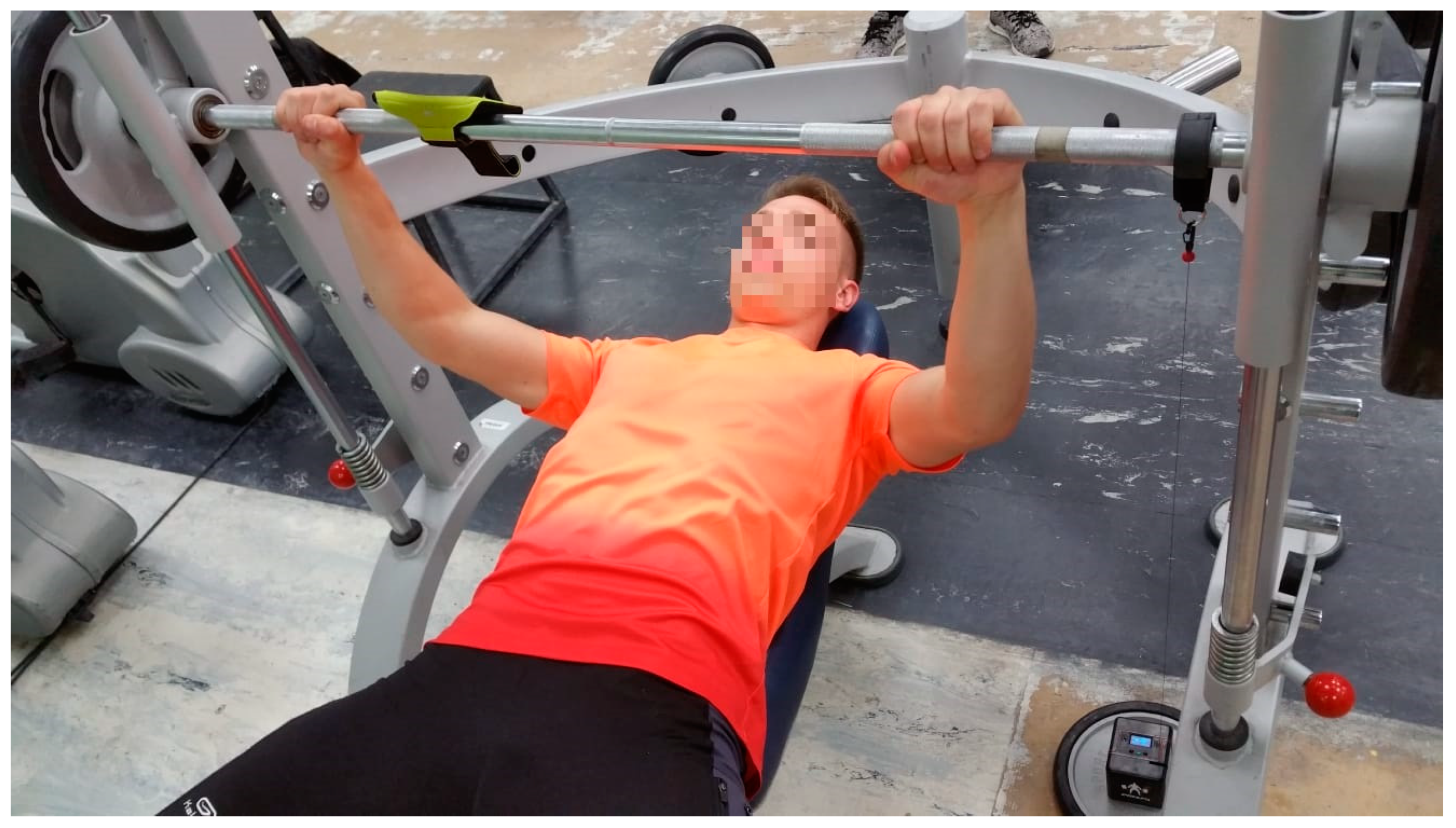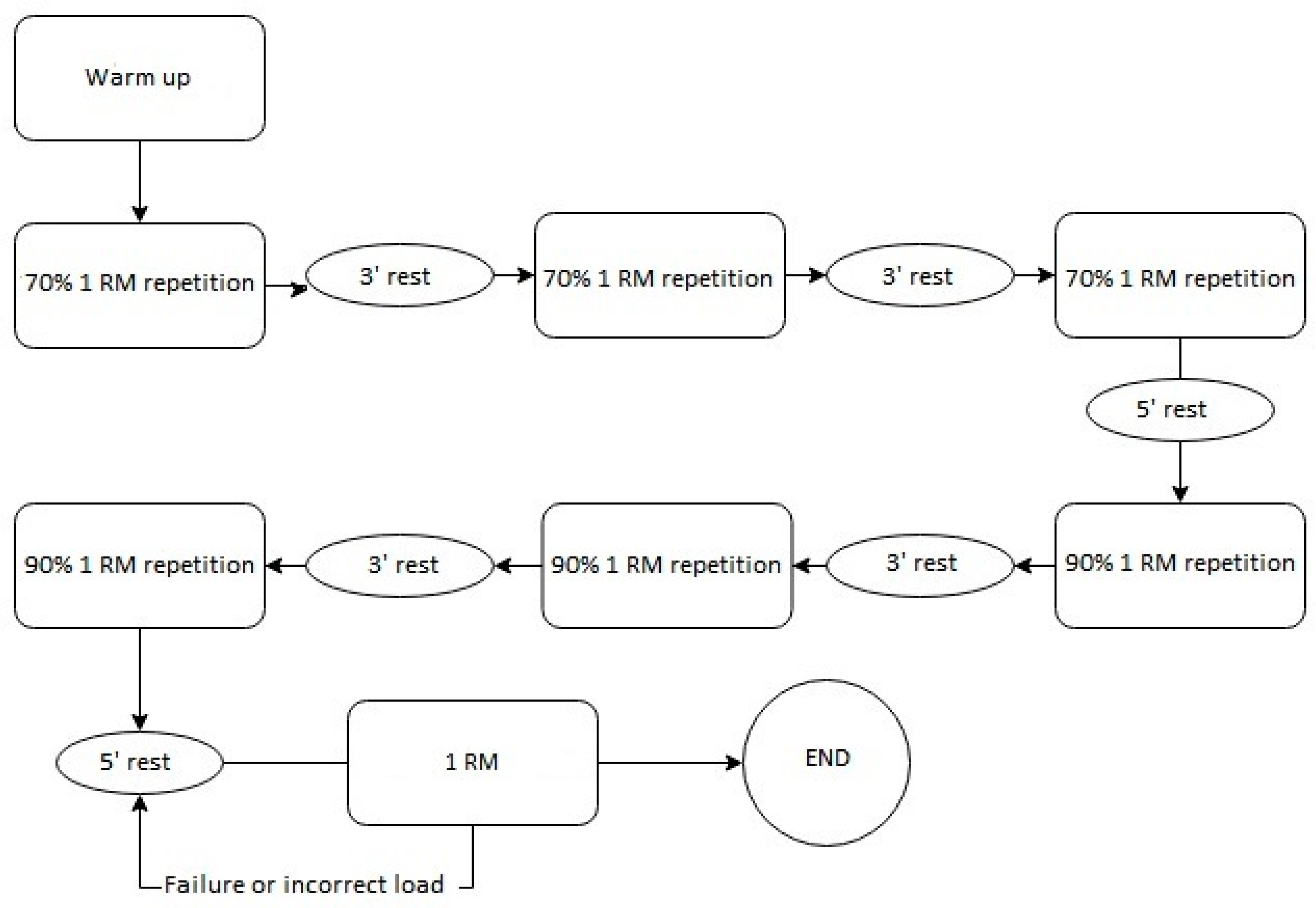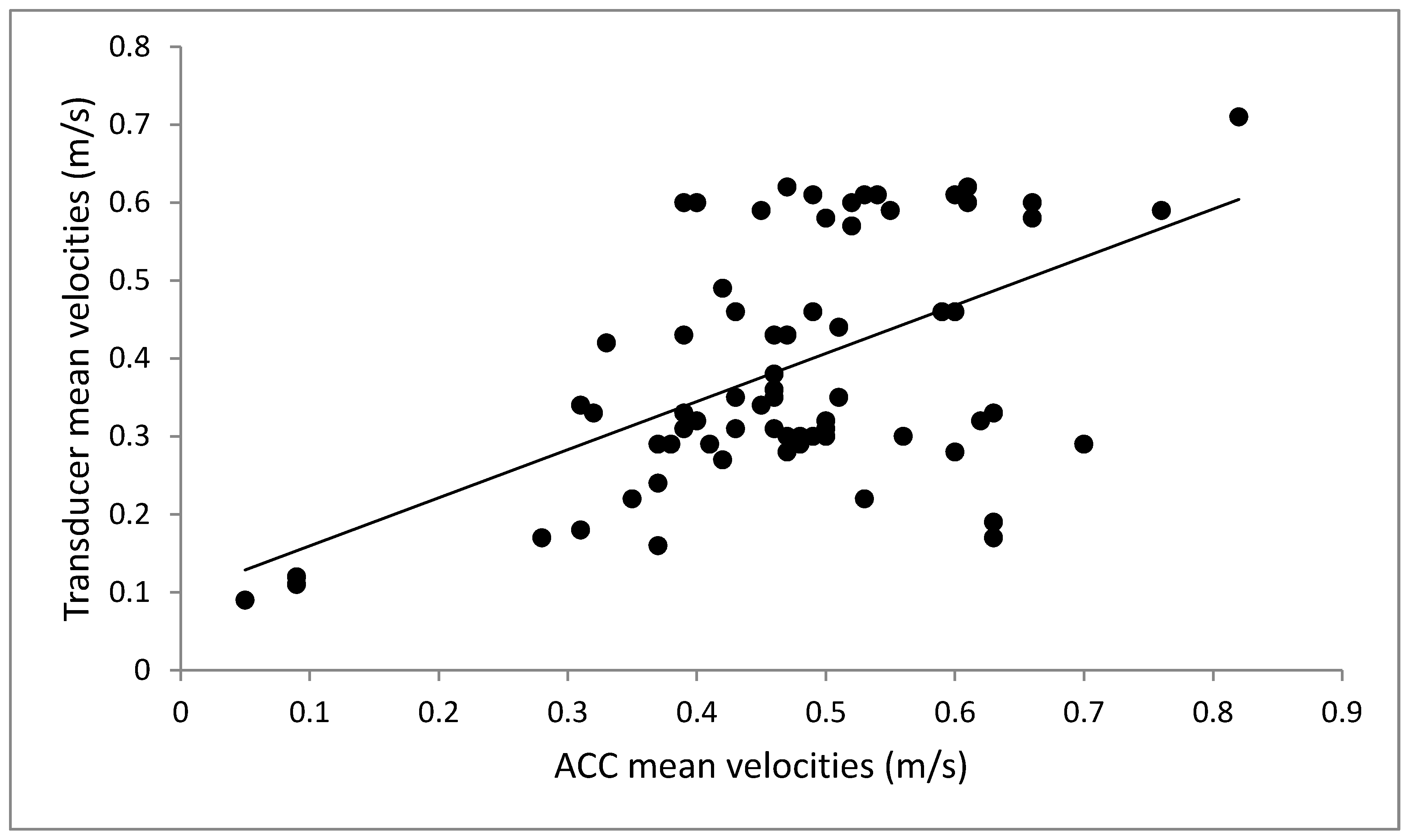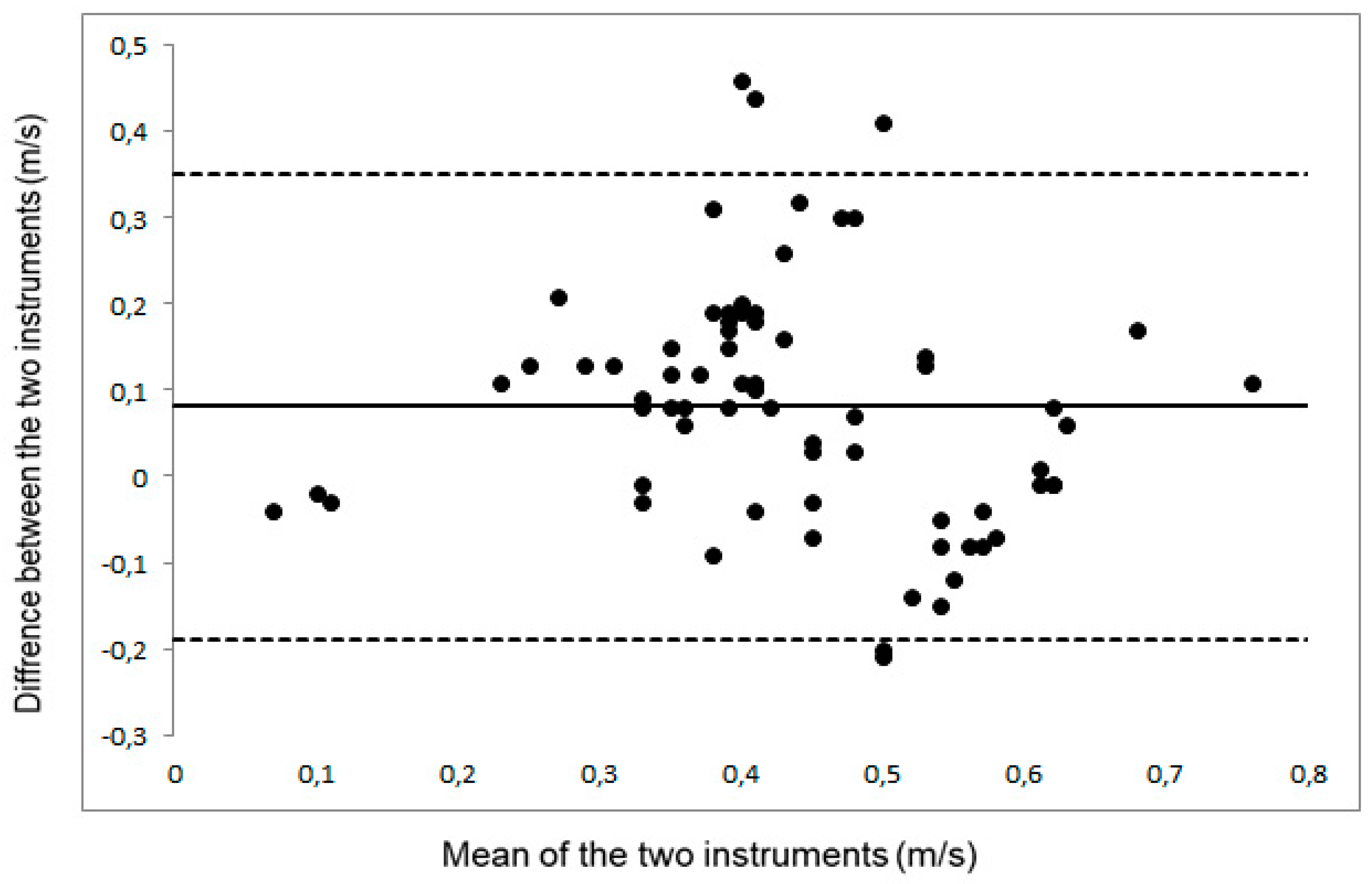1. Introduction
Resistance training has been the most-used method to increase athletes’ strength [
1]. To prescribe personalized resistance training programs, it is necessary to know the maximum load that the individual can move in each specific exercise or the lift velocity [
2].
The One-Repetition Maximum (1RM) test is a way to measure strength; however, it carries a high injury risk in non-highly trained populations [
3]. Even in high-level athletes, performing the 1RM test still has an injury risk and may require modifications in their training plans [
4]. Thus, different indirect methods have been proposed in the literature to estimate the 1RM value; e.g., muscular endurance methods [
5,
6,
7], anthropometric measurement methods [
8,
9,
10,
11], and lifting-velocity-based methods [
12,
13].
The 1RM estimation method based on lifting velocity has been demonstrated as a valid and reliable way to obtain the 1RM value without performing the lift with maximum load [
12,
13]. The gold-standard tool for measurement of the lifting velocity is the linear transducer [
12,
13], but it is an expensive instrument. There are other methods for measuring lift velocity, such as the use of video analysis [
14,
15] or professional accelerometers [
16,
17]. Nowadays, it is more and more common to find smartphone sports applications (APPs) specifically for velocity lifting analysis [
14] or to assess vertical jumping [
18]. Actual smartphones have inertial sensors (i.e., accelerometers, magnetometers, and gyroscopes) that are used to determine the position and displacement of the device [
19]. This technology could be used to measure lifting velocity [
20]. Nevertheless, as far as it is known, there is not any valid smartphone APP that uses this hardware in order to measure velocity and estimate strength.
The aim of this study was to determine the validity and reliability that a smartphone accelerometer (ACC) used by a mobile basic program (MBP) can provide to measure the propulsive (i.e., concentric) mean velocity of a bench-press (BP) lift in a Smith machine compared with a validated linear transducer.
It is hypothesized that the smartphone accelerometer used by a mobile basic program would be valid and reliable for measuring the lift mean velocity compared to a validated linear transducer.
2. Materials and Methods
2.1. Study Design
Ten volunteers performed three full-speed repetitions of BP on a Smith machine with a load of 70% 1RM, three repetitions with a load of 90% 1RM, and one repetition with a 1RM load. Loads of 70% and 90% of 1RM were chosen because of their use in 1RM estimation using a linear equation [
21]. Each repetition was measured simultaneously with a validated linear transducer, Speed4Lifts (Speed4Lifts, Madrid, Spain) [
20], and a smartphone ACC with the MBP, both attached to the bar (
Figure 1). Participants performed 70 BP lifts, whose mean propulsive (i.e., concentric) velocities were compared with statistical analyses to check the validity and reliability of the ACC.
2.2. Participants
Ten healthy young males with at least one year of experience in resistance training, specifically in BP, participated in this study (Mean ± SD; age = 23.1 ± 2.5 years; height = 175.3 ± 7.8 cm; weight = 73.2 ± 9.2 kg; 1RM BP = 82 ± 13.7 kg). The participants were recruited through information provided by one of the researchers to the students in university classrooms. The exclusion criteria were: (1) Age younger than 18 years; (2) having consumed any narcotic and/or psychotropic agents or drugs during the test; (3) any cardiovascular, metabolic, neurologic, pulmonary, or orthopedic disorder that could limit performance in the different tests; (4) having less than 12 months of experience in BP training. The study protocol adhered to the tenets of the declaration of Helsinki and was approved by the Ethics Committee of the Technical University of Madrid (Spain). At the outset of the study, participants were informed of the study protocol, the schedule and nature of the exercises, and tests to be performed before signing an informed consent form.
2.3. Procedure
Bench-Press Test
Participants were asked to not train muscles involved in the lift for at least 48 hours before the experiment. Before the test, they performed a warm-up [
14,
22] that consisted of five minutes of aerobic exercise (treadmill running), followed by dynamic stretches (e.g., internal and external shoulder rotations, elbow extensions, and wrist rotations) and upper-body joint mobility exercises (e.g., band pull-aparts, light pec-dec flys, and push-ups). Then, they performed two sets of five repetitions of BP around their 50% 1RM with two minutes of rest between sets. To finish the warm-up, the participants performed two sets of one repetition with 50% of 1RM at maximum speed in order to activate the musculature. During the test, each participant performed three sets of one repetition with a load of 70% 1RM and three minutes of rest between sets. The BP technique was standardized and controlled, and all participants were asked to use the same technique in each BP lift.
After the last 70% 1RM repetition, they rested for five minutes and began three sets of one repetition at 90% 1RM with three minutes of rest between sets. After the last 90% 1RM repetition, they rested five minutes and performed one 1RM attempt (see
Figure 2). If the subject failed the lift or the load was too light (velocity > 0.2 m/s) [
12], participants rested for five minutes and tried again using a newly incremented or decremented load (2.5% to 5%). All of the lifts were performed on the Smith machine (1XP113 Panatta Sport s.r.l X-Pression line, Macerata, Italy).
As soon as the participant took out the bar from the Smith Machine, they waited three seconds; then, the mobile basic program (MBP) emitted an acoustic signal (“LET’S GO”), and the participant did the descending phase (i.e., eccentric) of the lift until they touched their chest. Then, they stopped for one second with the bar on their chest, and with the second acoustic MBP warning (“BIP”), they performed the ascending phase (i.e., concentric) at maximum velocity. Both the MBP and the transducer registered the mean propulsive (i.e., concentric) lift velocity.
2.4. Instruments
The MBP was developed by one of the researchers (Computer Engineer) in the Android Studio Integrated Development Environment (Google, Mountain View, CA, USA) using the Java programming language (Oracle, Santa Clara, CA, USA). To capture the acceleration values, the sensorManager library was used. The MBP was installed in a Huawei G620S smartphone (Huawei Technologies Co., Guangdong, China), with an Android operating system (Google, Mountain View, CA, USA) and a lis3dh tri-axial accelerometer (STMicroelectronics, Geneva, Switzerland). The accelerometer uses a scale of ±2 g in this smartphone. The acceleration sampling frequency was set to 50 Hz because it is a value with a good noise/frequency relation. To calculate the mean propulsive lift velocity (i.e., concentric), accelerations were taken from the z axis of the smartphone, and the integration of those values was made using the integration principle:
To obtain the approach of the integration value, a trapezoidal rule was developed in code (1):
where
and n is the number of divisions.
The trapezoid rule divides the area under the curve, defined by acceleration values, into n trapezoids with different areas. The sum of the trapezoidal areas, contained under the curve, results in the approximated value of the curve integration. The greater the number of trapezoids, which matches with the number of acceleration events obtained during the concentric lift phase, the greater the precision of the integration approach [
23].
2.5. Algorithm Description
After pressing the start button, the MBP gives waiting time and emits a sound signal to start the lift. During the lift, acceleration values are captured and analyzed. First, the athlete performs the descending (eccentric) phase of the movement in a controlled way and stops for one second, just before the concentric phase (when the bar touches the chest). The MBP can detect the bench-press pause (there are no accelerations for a second) and emits a sound (“GO”) that signals the start of the propulsive phase (concentric). All of the propulsive phase accelerations are stored in an ArrayList data structure.
Then, the first filter, called a “mechanical filter”, is applied. The purpose of this filter is to eliminate all residual values that the accelerometer may have captured while standing still; those values should be 0, but are stored as a higher or lower value due to the low accelerometer quality. Subsequently, a low-pass filter is applied. This filter receives a smooth factor as a parameter; its algorithm is described in the following fragment of pseudocode:
function smoothArray( accelerationValues, smoothing ){
var value = accelerationValues[0 ]; // start with the first input
for (var i=1, len=accelerationValues.length; i<len; ++i){ // for traveling the ArrayList
var currentValue = accelerationValues[i];
value += (currentValue - value) / smoothing; // low-pass filter
accelerationValues[i] = value;
}
}
To obtain the acceleration using the trapezoidal rule, each one of the propulsive acceleration values is used to calculate its area. The base of the trapezoid is known (time between two captured acceleration events), as is the height of each side of the trapezoid (formed by two contiguous acceleration values). The result of the sum of all areas of the trapezoids will be the propulsive average speed of the lift.
2.6. Statistical Analyses
The normality of the data was analyzed by the Shapiro–Wilk test. Once the normality of the dependent variables was confirmed (
p > 0.05), all of the data were provided as their means and standard deviations. Different statistical analyses were used to prove the accelerometer’s (ACC) validity and reliability in comparison with the linear transducer. The ACC’s concurrent validity was tested using the Pearson correlation coefficient (r). Cohen’s convention was used to interpret the magnitude of the relationship between velocities measured by the ACC and the linear transducer [
24]. To test the ACC’s measurement reliability compared to that of the linear transducer, an absolute agreement Intraclass Correlation Coefficient (ICC) and Cronbach’s alpha were used. Bland–Altman plots were created to represent the agreement between the two instruments. The mean differences between the measurements were determined using a paired-sample t-test. The standard error of estimate (SEE) was used to show the typical error in measurement. Observer power (OP; 1 – β) was calculated to evaluate the strength of the statistical treatments. Significance was set at
p < 0.05. All statistical tests were performed using the software package SPSS® version 23 (IBM Co., USA).
4. Discussion
The smartphone accelerometer used by the mobile basic program was reliable at medium velocities (70% 1RM), but not at low-velocity lifts (90% and 100% 1RM). Therefore, it did not prove to be a totally valid and reliable tool for the measurement of concentric mean velocity of BP exercise in the Smith machine in comparison with a validated linear transducer. The data showed that the mean velocity values obtained by the ACC had a moderate correlation (r = 0.54) with a good level of agreement (ICC = 0.634) in comparison with the linear transducer. Additionally, the mean velocities measured with the ACC were significantly higher (mean difference: 0.08 m/s) compared to the mean velocities measured by the linear transducer.
When the differences between the mean velocities measured in the different 1RM percentages are specifically analyzed, no significant differences in the mean velocities at 70% 1RM can be seen between the ACC and the linear transducer (ACC = 0.52 ± 0.11 m/s; transducer = 0.54 ± 0.09 m/s). However, significant differences were found in the mean velocities in lifts with loads near 90% 1RM (ACC = 0.46 ± 0.09 m/s; transducer = 0.31 ± 0.03 m/s) and 100% 1RM (ACC = 0.33 ± 0.21 m/s; transducer = 0.16 ± 0.04 m/s). It seems that the APP measures the mean velocities with loads near 70% 1RM in a more precise way, showing a low difference of 0.02 m/s between the two devices. However, when loads are near 90%–100% 1RM, the measurement difference is higher and constant: 0.15 m/s. This higher and constant difference may be because the signal filter was not correctly programmed for slower velocities.
From a positive viewpoint, the data obtained in this study show that more precise adjustments in the filtering could be made in order to obtain results as good as those obtained in 70% 1RM lifts.
The linear transducer used in this study to compare the smartphone accelerometer accuracy measures the velocity of the vertical displacement of the cable attached to the bar using the transduction of electric signals. Thus, linear transducers are considered the gold-standard tool [
25] for measuring lift velocities. Other systems, like accelerometers, have been shown to be valid and reliable tools for measuring lift velocities [
16,
17,
18,
19,
20,
21,
22,
23,
24,
25,
26] and muscular power [
22].
Previously, other APPs for measuring lift velocities (e.g., the Powerlift APP) have been proven as valid and reliable tools [
14]. The main drawback of those APPs is that they do not measure the lift velocity or the acceleration. Hence, they need to know the Range of Motion (ROM) that must be measured and introduced by the user into the APP. Then, the user must choose the correct frames where the lift starts and ends. This way of measuring velocity needs a high-speed camera, because the greater the sampling frequency (frames/second) is, the greater the precision of determining the lifting time [
14]. It is important to know that some of the information of the space travelled between frames is always lost, and this could produce data loss in the barbell displacement velocity. Moreover, other mistakes may interfere with correct measurement using these APPs; e.g., ROM measurement must be made in the same way in order to avoid differences between the lifts. Due to the decisions that the observer must make (e.g., which frames are correct?), the probability of error rises and makes the measurement reproducibility harder.
The present study has combined smartphone accelerometer use and the development of a mobile basic program (MBP) that manages the accelerations obtained during the lift in order to directly measure lift velocity. Previously, the validity and reliability of other accelerometers, like the Beast Sensor, have been studied [
20]. They showed low validity and reliability at low speeds and a superior mean velocity compared to linear transducers. The accelerometers also showed a loss of a considerable number of repetitions that were not correctly detected by the sensor. APPs like Powerlift [
14] showed a precise measurement, but slightly higher than the measured linear transducer velocities. The validity and reliability of the results of the Powerlift APP depend on the video recording frequency in Hertz (Hz) and on the correct ROM measurement. These new technologies and this new APP overestimate mean lift velocity. However, these new technologies use better-quality accelerometers or allow for a manual process of frame selection and ROM measurement.
In the current study, the ACC validity and reliability could not be assured. This may be explained because, in the MBP, sampling frequency was set at 50 Hz, a lower value than in other accelerometers used for velocity measurement (i.e., 200 to 500 Hz) [
16,
26]. In addition, the building quality of accelerometers (e.g., Push band, Beast) [
16,
26] and their prices (i.e., 250–350 USD) are higher compared with the smartphone accelerometers, which are not meant to analyze movement with such high precision and which have a lower price (i.e., less than 5 USD). Therefore, it is hard to expect that the ACC in the present study will have better measurement precision compared to other higher-quality accelerometers and linear transducers. However, the objective is to have the closest measurements to the gold standard and to overtake the APPs that use video frames to measure velocity. The use of the smartphone accelerometer presented in this study is a low-cost approximation of a linear transducer that could be, in the near future, accessible and useful for coaches.
Limitations
The sample number of load ranges in the study is limited, and lower load ranges (e.g., 40% and 60% of 1RM) should be tested in future studies.
5. Conclusions
In comparison with a validated linear transducer, the smartphone accelerometer used by a mobile basic program presented in this study is valid and reliable for mean propulsive velocities with around 70% of 1RM, for a BP lift in a Smith machine, but not in lower velocity ranges. It can be useful for coaches because most users will lift loads near to their 70% of 1RM. This technology could be a cheap, fast, and easy way to measure velocity for coaches in order to plan strength training sessions in the near future.
In future studies, it is warranted to investigate the development of an APP in which accelerometer signal filtering will be enhanced in lower-velocity lifts in order to improve the measurement results in velocity ranges near 90%–100% 1RM. In addition, lower load ranges, such as 40% and 60% of 1RM, will be tested. Moreover, the APP’s behavior will be tested in other smartphones with different accelerometers and operating systems to try to improve and adjust the APP’s sampling frequency. This study intends to provide some new perspectives on the use of smartphone sensors in order to improve sport performance.










